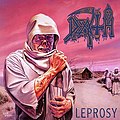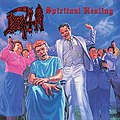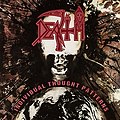Death (metal band): Difference between revisions
| Line 50: | Line 50: | ||
==Trivia== |
==Trivia== |
||
*Schuldiner designed the Death logo and its various incarnations during the length of his career. In 1991, before the release of ''[[Human (album)|Human]]'', he cleaned up the logo taking out more intricate details, |
*Schuldiner designed the Death logo and its various incarnations during the length of his career. In 1991, before the release of ''[[Human (album)|Human]]'', he cleaned up the logo taking out more intricate details, then in 1995 the "T" in the logo was swapped from an inverted Cross to a more regular looking "T". |
||
== Band members == |
== Band members == |
||
Revision as of 01:12, 25 November 2007
Death |
|---|
Death was an influential American death metal band founded in 1983 by guitarist and vocalist Chuck Schuldiner, and dissolved in 1999. They are widely credited as the creators of the death metal genre, from the release of their first demo in 1984. The band's label debut Scream Bloody Gore is considered a template of the genre, described as death metal's first archetypal document.[1] Schuldiner was the only member to remain in the band from start to end. Music biographers have referred to Schuldiner as the father of death metal.[2]
Biography
Early history (1983-1987)
Founded in 1983 by Chuck Schuldiner under the original name of Mantas in Orlando, Death were among the more widely known, early pioneers of the death metal sound along with fellow Florida band Morbid Angel. In the late 80s, the band was both a part of and integral in defining the death metal scene which gained international recognition with the release of albums by a number of area acts.
Together with Kam Lee (Barney Lee), and Rick Rozz (Frederick DeLillo), Schuldiner started to compose songs that were released on several rehearsal tapes in 1984. These tapes, along with the Death by Metal demo, circulated through the tape trader world, quickly establishing the band's name. In 1984, Schuldiner dissolved Mantas and quickly started a new band under the name Death. Its members included the same Rick Rozz and Kam Lee. Another demo was released, called Reign of Terror.
In 1985, after the Infernal Death tape was recorded and released, Schuldiner fired Lee and Rozz in favour of Repulsion's bassist and guitarist, Scott Carlson and Matt Olivio, respectively. However, a drummer could not be found; consequently the band dissolved again. Schuldiner moved to San Francisco and recruited DRI drummer Eric Brecht, but he was not happy with this incarnation of Death and moved back to Florida without a band. There, in 1986, Schuldiner got an invitation from early Canadian thrash band Slaughter to play on their album, which he accepted, moving to Canada. This only lasted two weeks, however, as he found the situation not to his liking. He returned to Florida, then moved quickly to San Francisco again, where he joined with Chris Reifert. They recorded the Mutilation demo, which led to a deal with Combat Records, owned by Important Distribution (later becoming Relativity), that enabled them to record the first LP.
Scream Bloody Gore was released in 1987. Schuldiner briefly had a second guitar player, John Hand, but Hand did not appear on the album (though his photo did). By this time Schuldiner moved back to Florida, leaving Chris Reifert behind. There, Schuldiner teamed up with former bandmate Rick Rozz and two members of Rozz's band Massacre, Terry Butler and Bill Andrews.
The mid-era (1988-1992)
In 1988, that lineup recorded Leprosy. After much gigging in support of the album, including a quick and ill-planned tour of Europe, Rick Rozz was fired in 1989. After a tour of Mexico featuring guitarist Paul Masvidal (later to re-emerge in the Death camp), a replacement was found in James Murphy, with whom the third album Spiritual Healing was recorded in Tampa in the summer of 1989. Murphy was sacked relatively quickly. By this time Schuldiner abandoned the "gore" lyrical theme for more social critique as Death's musical style progressed from simple brutal death metal to complex, technical death metal. Additional melody was added to the band's sound as well as more varied timings and song structures.
In 1990, on the eve of a European tour, Schuldiner decided against traveling, claiming at the last minute that he felt the tour was not adequately organized (and citing the group's previous disorganized European tour in 1988). Andrews and Butler continued with the tour of Europe as 'Death' regardless and recruited roadies Walter Trachsler (guitar) and Louie Carrisalez (vocals) to replace Schuldiner, much to Schuldiner's shock and disgust. Schuldiner took legal action and Butler and Andrews were expelled from the band.
Schuldiner abandoned the idea of a band set-up altogether and began working with session musicians only. Schuldiner hired Steve DiGiorgio and recruited Sean Reinert and Paul Masvidal from underground Florida band Cynic. In 1991, Death released Human, which is considered a more technical and progressive album than their previous works. Human was Death's best-selling album yet, receiving many accolades and some MTV play for the group's first video, directed by David Bellino, for the track Lack of Comprehension. Due to obligations with his primary band Sadus, DiGiorgio was forced to depart after the recording of Human and new bassist Skott Carino did Death's extensive world tour, from October 1991 until March 1992, in addition to appearing in the music video for Lack of Comprehension.
During this period of 1988-92, Death was managed by Eric Greif, a rocky relationship that culminated in at least two lawsuits between Greif and Schuldiner. However, when interviewed by Thrash 'n Burn, Schuldiner was characteristically mellow about what the writer referred to as his "gruesome collaboration" with Greif: "We just came to the conclusion that it was stupid just fighting all the time, taking each other to court and all that stupid shit." After his final break from Greif, Schuldiner managed himself for the remainder of his career.
The final years (1993-2001)
In 1993, Reinert and Masvidal left the group to continue with Cynic, Schuldiner being unable to persuade them otherwise. Schuldiner replaced them with Gene Hoglan of the recently dissolved thrash metal band Dark Angel, and worked with guitarist Andy LaRocque from King Diamond for Individual Thought Patterns. LaRocque being obligated to his band, Schuldiner hired a then-unknown Ralph Santolla as touring guitarist. Death was arguably at the peak of their commercial and popular culture success, and the video for the track The Philosopher, a lyrical slam against former guitarist Masvidal,[3] even made it on to a Beavis & Butt-head episode in 1994 (Beavis also parodies Schuldiner's vocals in a mock 'drive-thru' order of 'tacos, to go!' in death-metal style). Also in 1994, Death abandoned their eight year relationship with Relativity and signed with Roadrunner Records, their European distributor. For 1995's Symbolic, Santolla and DiGiorgio were exchanged for underground Florida musicians Kelly Conlon and Bobby Koelble. For the Symbolic tour Brian Benson was brought in on bass (Conlon having left the band prior to the tour due to conflicts with Schuldiner).
After Symbolic, Schuldiner dissolved the band and all ties with Roadrunner and began writing songs for Control Denied. It was during this time that Schuldiner briefly worked with Florida studio guitarist James Hogan. Schuldiner was still contractually obligated to record an album under Nuclear Blast with Death, and so he used several songs that were intended to be used for Control Denied, as several song titles on The Sound of Perseverance were originally Control Denied song titles. He re-formed Death with Florida musicians Richard Christy, Shannon Hamm and Scott Clendenin to record 1998's The Sound of Perseverance with his new label Nuclear Blast.
After the album and two supporting tours, Schuldiner dissolved Death to pursue Control Denied with Christy and Hamm. Clendenin was dropped in favor of Steve DiGiorgio, who was once again available, and an underground power metal singer named Tim Aymar. As Schuldiner finished Control Denied's debut album, he was diagnosed with brain cancer, forcing the band to scrap plans for a US and Canadian tour. As he worked on the second release, Schuldiner's condition improved, but the tumor left him in a weakened, vulnerable state. He contracted pneumonia and was placed in the hospital. He was released and returned home where, one hour later, Schuldiner died on December 13, 2001.
The aftermath
The second Control Denied release has yet to be completed and is mired in a variety of odd legal problems involving its label, the musicians (who have publicly stated their desire to complete the album) and Schuldiner's mother. In 2004, Hammerheart Records released a CD made up of old, pre-Scream Bloody Gore demos, along with partial demos of the unfinished album. This was issued under the name Chuck Schuldiner, not Death, but their markedly unfinished state and lack of vocals led few to pay attention, aided by Schuldiner's mother's pleas for fans to stay away from it.
Members of Death have dispersed all throughout the landscape of metal and popular music. Some, like Gene Hoglan from Dark Angel and Andy LaRocque from King Diamond, already had made a name for themselves. Others went on to do so, like Sean Reinert, who formed the legendary Cynic with fellow Death member Paul Masvidal. Ironically, both of these pioneering death metal musicians have ended up in a progressive, ethereal rock band named Æon Spoke, laced with delicate guitars and Masvidal's soft croon. Richard Christy went on to gigs with Acheron and Iced Earth before joining The Howard Stern Show. Ralph Santolla has also played with Iced Earth, as well as Sebastian Bach, both of which were also stations for Steve DiGiorgio (he's still playing with Bach). While Santolla is now in Obituary and before this he was in Deicide. DiGiorgio also played for Testament and is still active with his original band Sadus. Bobby Koelble founded the Orlando rock-funk-Latin fusion group JunkieRush in 2000. James Murphy was also in Testament for awhile, formed numerous projects such as Disincarnate (as well as stints with death metal bands Obituary and Cancer) and has made a name for himself. Murphy also has been stricken with cancer and, along with Deron Miller of CKY, is organizing a Death tribute album to be released upon completion. Recently, Kam Lee formed the band Denial Fiend with Terry Butler.
Trivia
- Schuldiner designed the Death logo and its various incarnations during the length of his career. In 1991, before the release of Human, he cleaned up the logo taking out more intricate details, then in 1995 the "T" in the logo was swapped from an inverted Cross to a more regular looking "T".
Band members
Last known lineup
- Chuck Schuldiner − Vocals, Lead and Rhythm Guitars, main songwriter (1983-2001)
- Shannon Hamm − Guitars (1996-2001)
- Scott Clendenin − Bass (1996-2001)
- Richard Christy − Drums (1996-2001)
Previous members
Guitarists
- Rick Rozz (Frederick DeLillo) − Guitars (1983-1985, 1987-1989)
- Matt Olivo − Guitar (1985)
- John Hand − Guitar (Never played anything live or on any album, but credited on Scream Bloody Gore[4]) (1987)
- Paul Masvidal − Guitar (1989, 1991-1992)
- Albert Gonzalez − Guitar (1990)
- James Murphy − Guitar (1989)
- Andy LaRocque (Anders Allhage) − Guitar (1993)
- Ralph Santolla − Live Guitar (1993)
- Craig Locicero − Guitar (1993)
- Bobby Koelble − Guitar (1995)
Bassists
- Scott Carlson − Bass (1985)
- Eric (last name unknown) − Bass (1985)
- Terry Butler − Bass (1987-1990)
- Steve DiGiorgio − Bass (1986, 1991, 1993)
- Skott Carino − Bass (1991-1992)
- Kelly Conlon − Bass (1995)
- Brian Benson − Bass (Symbolic Tour)
Drummers
- Kam Lee (Barney Lee) − Drums, Vocals (1983-1985)
- Eric Brecht − Drums (1985)
- Chris Reifert − Drums (1986-1987)
- Bill Andrews − Drums (1987-1990)
- Sean Reinert − Drums (1991-1992)
- Gene Hoglan − Drums (1993-1995)
- Richard Christy − Drums (1995-2001)
Discography
Demos
- Death by Metal (demo as Mantas, 1983)
- Reign of Terror (demo, 1984)
- Live at Ruby's Pub (live-demo, 1984)
- Infernal Death (demo, 1985)
- Rigor Mortis (demo, 1985)
- Back from the Dead (demo, 1985)
- Infernal Live (Demo, 1985)
- Mutilation (demo, 1986)
Albums
Videography
- Lack of Comprehension (videoclip, 1991)
- The Philosopher (videoclip, 1993)
- Live in Houston (Bootleg, VHS, 04.02.1989)
- Live in Florence (VHS, 10.12.1993)
- Live in Music Hall (1998, Virus Cable TV)
- Live in L.A. (Death & Raw) (Official Live, DVD/VHS, 05.12.1998)
- Live in Eindhoven (Official Live, DVD), 2001, Nuclear Blast)
See also
- Control Denied - Second band of Chuck Schuldiner.
- Voodoocult - An all-star band in which Chuck played guitar
References
External links
- Memorial site for Chuck Schuldiner
- Death at the All Music Guide
- Death discography at MusicBrainz
- Death former manager









